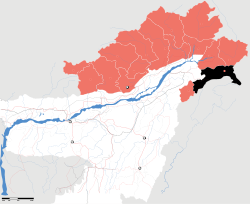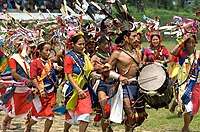Changlang district
Changlang district (Pron:/tʃæŋˈlæŋ/) is located in the Indian state of Arunachal Pradesh, located south of Lohit district and north of Tirap district. As of 2011 it is the second most populous district of Arunachal Pradesh (out of 16), after Papum Pare.[1]
Changlang district | |
|---|---|
District of Arunachal Pradesh | |
 Location of Changlang district in Arunachal Pradesh | |
| Country | India |
| State | Arunachal Pradesh |
| Division | Arunachal East |
| Headquarters | Changlang |
| Area | |
| • Total | 4,662 km2 (1,800 sq mi) |
| Population (2011) | |
| • Total | 148,226[1] (2,011) |
| Demographics | |
| • Literacy | 61.9%[1] |
| • Sex ratio | 914[1] |
| Time zone | UTC+05:30 (IST) |
| Website | changlang |

History
Post-independence
The district was created on 14 November 1987, when it was split from Tirap district.[2]
Geography
Changlang district occupies an area of 4,662 square kilometres (1,800 sq mi),[3] comparatively equivalent to Indonesia's Lombok Island.[4]
It falls in a region that receives high rainfall. The region is rich in wildlife with a different kind of flora and fauna. The district has both plains and highlands. Most of the plains are in the valley of Dihing. The area is prone to occasional floods.
National protected area
Economy
The Dihing is the main source of fishes for the local people. The freshwater fishes are very much in demand they hardly reach major towns nearby like Tinsukia, Doomdooma, Digboi and Dibrugarh.
Administrative divisions
There are 5 Arunachal Pradesh Legislative Assembly constituencies located in this district: Bordumsa, Miao, Nampong, Changlang South and Changlang North. All of these are part of Arunachal East Lok Sabha constituency.[5]
The Changlang district has five Sub-Divisions namely Changlang, Manmao, Jairampur, Bordumsa, and Miao.
Changlang Sub-Divisions (Chanlang Block) covers four circles, namely Changlang (14,718 people), Khimiyang (3,506 people), Namtok (3,085 people) and Yatdam.
Manmao Sub-Division (Manmao Block) covers three Circles, namely Manmao (3,814 people), Renuk, and Lyngok-Longtoi.
Jairampur Sub-Division (Nampong Block) covers three Circles, namely Nampong (4,424 people), Jairampur (7,836 people) and Rima-Putak.
Bordumsa Sub-Division (Bordumsa-Diyun Block) has got only two circles Bordumsa (25,369 people) and Diyun (28,907 people).
And Miao Sub-Division (Khagam-Miao Block) covers three circles namely Miao (20,266 people), Kharsang (9,509 people) and Vijoynagar (3,988 people).
Total, there are fifteen Circles, five Blocks, and five Subdivisions in Changlang district.
There are two municipalities Changlang (6,469 people) and Jairampur (5,919 people).
The administrative setup is based on single-line administration which aims to keep close co-operation amongst various developmental departments with the district administration and thus, to work together for the speedy development of the area. The district has four Sub-Divisions and a total of 12 circles as shown in Table 2.1 below. The Deputy Commissioner is the overall in-charge of the district administration maintains law and order with the help of administrative officers and police forces. Moreover, the villagers have their own customary administrative systems in the form of traditional village councils consisting of the Gaon Buras and members.
Transport
There is no good road transport in the region. The people are commuting on the roads that Oil India Limited build some decades back.
The 2,000-kilometre-long (1,200 mi) proposed Mago-Thingbu to Vijaynagar Arunachal Pradesh Frontier Highway along the McMahon Line,[6][7][8][9] (will intersect with the proposed East-West Industrial Corridor Highway) and will pass through this district, alignment map of which can be seen here and here.[10]
Demographics
| Historical population | ||
|---|---|---|
| Year | Pop. | ±% p.a. |
| 1961 | 18,227 | — |
| 1971 | 41,474 | +8.57% |
| 1981 | 62,211 | +4.14% |
| 1991 | 95,530 | +4.38% |
| 2001 | 125,422 | +2.76% |
| 2011 | 148,226 | +1.68% |
| source:[11] | ||
According to the 2011 census Changlang district has a population of 148,226,[12] roughly equal to the nation of Saint Lucia.[13]
This gives it a ranking of 598th in India (out of a total of 640 districts). The district has a population density of 32 inhabitants per square kilometre (83/sq mi). Its population growth rate over the decade 2001–2011 was 17.96%. Changlang has a sex ratio of 914 females for every 1000 males, and a literacy rate of 61.9%.[12]
Changlang is populated by tribal groups, namely Tangsa, Tutsa, Nocte, Chakma, Singpho, Gorkha and the Yobin. Sizeable communities of the Tibetans,[14] Hajong and Bodo.
The Tibetan people are clustered at Choephelling Tibetan settlement in Miao, which was set up in 1976 hosts a population of 2200.[15]
Languages
Languages spoken are of endangered Sino-Tibetan tongue with 30 000 speakers, spoken in the northeastern part of the district.[16]
Religion
Religion in Changlang diatrict (2011)[17]
Culture
Tourism
Places to visit are World War II cemetery in Jairampur, Indo-Myanmar border town Nampong and Pangsau Pass. Another place of interest is Bordumsa where the rich culture of the Tais and Singpho exist.
Flora and fauna
The Namdapha Tiger reserve is located in Miao town of this district.
Health services
Although the region is one of the most populous in Arunachal Pradesh, there are hardly any hospitals. It is a great challenge to travel to good hospitals in Assam.
References
- "District Census 2011". Census2011.co.in.
- Law, Gwillim (25 September 2011). "Districts of India". Statoids. Retrieved 11 October 2011.
- Srivastava, Dayawanti et al. (ed.) (2010). "States and Union Territories: Arunachal Pradesh: Government". India 2010: A Reference Annual (54th ed.). New Delhi, India: Additional Director General, Publications Division, Ministry of Information and Broadcasting (India), Government of India. p. 1113. ISBN 978-81-230-1617-7.CS1 maint: extra text: authors list (link)
- "Island Directory Tables: Islands by Land Area". United Nations Environment Program. 18 February 1998. Retrieved 11 October 2011.
Lombok 4,625 km2
- "Assembly Constituencies allocation w.r.t District and Parliamentary Constituencies". Chief Electoral Officer, Arunachal Pradesh website. Archived from the original on 13 August 2011. Retrieved 21 March 2011.
- Dipak Kumar Dash. "Top officials to meet to expedite road building along China border". The Times of India. Retrieved 27 October 2014.
- "Narendra Modi government to provide funds for restoration of damaged highways". Retrieved 27 October 2014.
- Ankit Panda. "Indian Government Plans Highway Along Disputed China Border". thediplomat.com. Retrieved 27 October 2014.
- "Govt planning road along McMohan line in Arunachal Pradesh: Kiren Rijiju". Live Mint. Retrieved 26 October 2014.
- Ajay Banerjee. "China warns India against paving road in Arunachal". tribuneindia.com. Retrieved 26 October 2014.
- Decadal Variation In Population Since 1901
- "District Census 2011". Census2011.co.in. 2011. Retrieved 30 September 2011.
- US Directorate of Intelligence. "Country Comparison:Population". Retrieved 1 October 2011.
Saint Lucia 161,557 July 2011 est.
- Tibetans in Miao Elect Settlement Officer Archived 11 March 2007 at the Wayback Machine. Tibet.net (24 October 2003).
- Choepheling Tibetan Settlement, Miao, Arunachal Pradesh, India Archived 4 November 2005 at the Wayback Machine
- M. Paul Lewis, ed. (2009). "Galo: A language of India". Ethnologue: Languages of the World (16th ed.). Dallas, Texas: SIL International. Retrieved 28 September 2011.
- "Population by religion community – 2011". Census of India, 2011. The Registrar General & Census Commissioner, India. Archived from the original on 25 August 2015.
External links
| Wikimedia Commons has media related to Changlang district. |